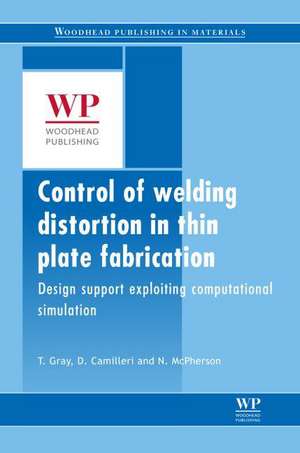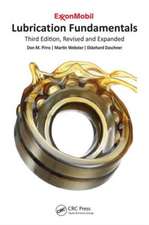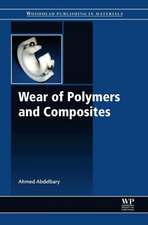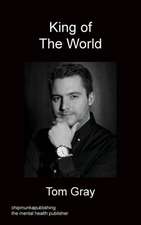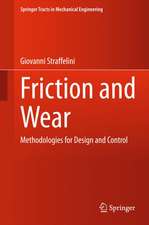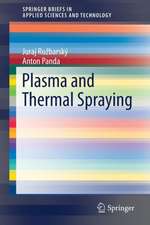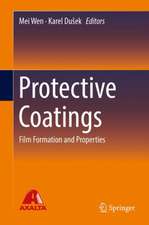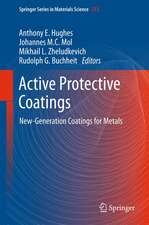Control of Welding Distortion in Thin-Plate Fabrication: Design Support Exploiting Computational Simulation
Autor Tom Gray, D. Camilleri, N. McPhersonen Limba Engleză Hardback – 19 ian 2014
The book is structured as an integrated treatment. It opens by reviewing the development of computational welding mechanics approaches to distortion. Following chapters describe the industrial context of stiffened plate fabrication and further chapters provide overviews of distortion mechanics and the modeling approach. A chapter on full-scale welding trials is followed by three chapters that develop modeling strategies through thermal process and thermo-mechanical simulations, based on finite-element analysis. Simplified models are a particular feature of these chapters. A final sequence of chapters explores the simulation of welding distortion in butt welding of thin plates and fillet welding of stiffened plate structures, and shows how these models can be used to optimize design and fabrication methods to control distortion.
Control of Welding Distortion in Thin-Plate Fabrication is a comprehensive resource for metal fabricators, engineering companies, welders and welding companies, and practicing engineers and academics with an interest in welding mechanics.
- Allows practitioners in the field to minimize distortion during the welding of thin plates
- Provides computational tools that can give insight into the effects of welding and fabrication procedures
- Demonstrates how welding distortion in thin plate fabrications can be minimized through design
Preț: 873.71 lei
Preț vechi: 1272.81 lei
-31% Nou
Puncte Express: 1311
Preț estimativ în valută:
167.24€ • 181.72$ • 140.57£
167.24€ • 181.72$ • 140.57£
Carte tipărită la comandă
Livrare economică 15-29 aprilie
Preluare comenzi: 021 569.72.76
Specificații
ISBN-13: 9780857090478
ISBN-10: 085709047X
Pagini: 352
Ilustrații: illustrations (black and white, and colour)
Dimensiuni: 156 x 234 x 25 mm
Greutate: 0.66 kg
Editura: ELSEVIER SCIENCE
ISBN-10: 085709047X
Pagini: 352
Ilustrații: illustrations (black and white, and colour)
Dimensiuni: 156 x 234 x 25 mm
Greutate: 0.66 kg
Editura: ELSEVIER SCIENCE
Cuprins
Author contact details
Woodhead Publishing Series in Welding and Other Joining Technologies
Preface
1. Introduction: development of computational welding mechanics approach to welding distortion
Abstract:
1.1 Background: control of welding distortion in fabrication practice
1.2 Aims: integrated design approach utilising computational welding mechanics (CWM)
1.3 Structure of the book
1.4 Conclusion
1.5 References
2. Fabrication of stiffened thin-plate structures and the problem of welding distortion
Abstract:
2.1 Introduction
2.2 Welding distortion of stiffened-plate and other fabricated structures
2.3 Outline of a typical fabrication process
2.4 Raw materials and primary process factors
2.5 Management issues relevant to thin-plate distortion
2.6 Rectification of thin-plate distortion
2.7 Conclusion
2.8 References
3. Tools to deal with welding distortion: predictive modelling and research on in-process techniques
Abstract:
3.1 Introduction
3.2 Artificial neural networks (ANNs)
3.3 Computational simulation
3.4 Current research on reduction of distortion
3.5 Conclusion
3.6 References
4. Understanding welding distortion: thermal fields thermo-mechanical effects
Abstract:
4.1 Introduction
4.2 Thermal fields: dependence on welding parameters and material properties
4.3 Thermo-mechanical effects
4.4 Thermo-mechanical treatment based on longitudinal–transverse uncoupling
4.5 Plane strain strip: longitudinal deformations and forces
4.6 Transverse welding deformations
4.7 Residual stress
4.8 Buckling
4.9 Conclusion
4.10 References
5. Computational simulation of welding distortion: an overview
Abstract:
5.1 Introduction
5.2 Multi-physics
5.3 Thermal property non-linearity
5.4 Phase change and non-linear thermal dilatation
5.5 Mechanical property idealisation
5.6 Thermal computation outline
5.7 Range of thermo-mechanical approaches available
5.8 Reduced solutions and their advantages
5.9 Conclusion
5.10 References
6. Experimental investigation of models of welding distortion: methods, results and comparisons
Abstract:
6.1 Introduction
6.2 Importance of experimental observations
6.3 Welding process application in test work
6.4 Thermocouple arrays
6.5 Thermography
6.6 Deformation measurement
6.7 Completion and smoothing of measured deformation profiles
6.8 Characterising out-of-plane deformation
6.9 Conclusion
6.10 References
7. Modelling thermal processes in welding
Abstract:
7.1 Introduction
7.2 Convection and radiation
7.3 Heat input modelling
7.4 Simulation of weld deposition
7.5 Thermal property non-linearity
7.6 Three-dimensional transient thermal computation
7.7 Transient finite-element model based on two-dimensional cross-section
7.8 Thermal computation in stiffener fillet weld geometries
7.9 Welding efficiency
7.10 Thermal cutting
7.11 Conclusion
7.12 References
8. Computationally efficient methods for modelling welding processes
Abstract:
8.1 Introduction
8.2 Computationally efficient methods based on algorithms
8.3 Hybrid stepwise solution methods
8.4 Conclusion
8.5 References
9. Finite-element thermo-mechanical techniques for welding distortion prediction
Abstract:
9.1 Introduction
9.2 Formulation of thermo-mechanical finite-element model
9.3 Case study: influence of tacking procedures on butt-weld distortion
9.4 Case study: fillet-welded stiffened plate
9.5 Conclusion
9.6 References
10. Simulating welding distortion in butt welding of thin plates
Abstract:
10.1 Introduction
10.2 Plate support and out-of-flatness influences
10.3 Effects of tacking
10.4 Clamping effects
10.5 Residual stress in butt welds
10.6 Multiple butt welds
10.7 Conclusion
10.8 References
11. Simulating welding distortion in fillet welding of stiffened plate structures
Abstract:
11.1 Introduction
11.2 Plates with double-sided continuous fillet-welded single stiffeners: thermal aspects
11.3 Plates with double-sided continuous fillet-welded single stiffeners: computationally efficient thermomechanical treatment
11.4 Multiply-stiffened plates: case study on welding sequence
11.5 Conclusion
11.6 References
12. Exploiting welding distortion models: examples of design and manufacturing strategies to optimise fabrication
Abstract:
12.1 Introduction
12.2 Optimising multi-stiffener configuration
12.3 Optimising the design in terms of weld position
12.4 Limiting heat input to avoid buckling
12.5 Simulation of transient thermal tensioning: fabrication-related distortion reduction study
12.6 Simulated use of low-transformation-temperature filler material to reduce distortion
12.7 Simulated use of weld-trailing cryogenic cooling process to reduce distortion
12.8 Conclusion
12.9 References
Index
Woodhead Publishing Series in Welding and Other Joining Technologies
Preface
1. Introduction: development of computational welding mechanics approach to welding distortion
Abstract:
1.1 Background: control of welding distortion in fabrication practice
1.2 Aims: integrated design approach utilising computational welding mechanics (CWM)
1.3 Structure of the book
1.4 Conclusion
1.5 References
2. Fabrication of stiffened thin-plate structures and the problem of welding distortion
Abstract:
2.1 Introduction
2.2 Welding distortion of stiffened-plate and other fabricated structures
2.3 Outline of a typical fabrication process
2.4 Raw materials and primary process factors
2.5 Management issues relevant to thin-plate distortion
2.6 Rectification of thin-plate distortion
2.7 Conclusion
2.8 References
3. Tools to deal with welding distortion: predictive modelling and research on in-process techniques
Abstract:
3.1 Introduction
3.2 Artificial neural networks (ANNs)
3.3 Computational simulation
3.4 Current research on reduction of distortion
3.5 Conclusion
3.6 References
4. Understanding welding distortion: thermal fields thermo-mechanical effects
Abstract:
4.1 Introduction
4.2 Thermal fields: dependence on welding parameters and material properties
4.3 Thermo-mechanical effects
4.4 Thermo-mechanical treatment based on longitudinal–transverse uncoupling
4.5 Plane strain strip: longitudinal deformations and forces
4.6 Transverse welding deformations
4.7 Residual stress
4.8 Buckling
4.9 Conclusion
4.10 References
5. Computational simulation of welding distortion: an overview
Abstract:
5.1 Introduction
5.2 Multi-physics
5.3 Thermal property non-linearity
5.4 Phase change and non-linear thermal dilatation
5.5 Mechanical property idealisation
5.6 Thermal computation outline
5.7 Range of thermo-mechanical approaches available
5.8 Reduced solutions and their advantages
5.9 Conclusion
5.10 References
6. Experimental investigation of models of welding distortion: methods, results and comparisons
Abstract:
6.1 Introduction
6.2 Importance of experimental observations
6.3 Welding process application in test work
6.4 Thermocouple arrays
6.5 Thermography
6.6 Deformation measurement
6.7 Completion and smoothing of measured deformation profiles
6.8 Characterising out-of-plane deformation
6.9 Conclusion
6.10 References
7. Modelling thermal processes in welding
Abstract:
7.1 Introduction
7.2 Convection and radiation
7.3 Heat input modelling
7.4 Simulation of weld deposition
7.5 Thermal property non-linearity
7.6 Three-dimensional transient thermal computation
7.7 Transient finite-element model based on two-dimensional cross-section
7.8 Thermal computation in stiffener fillet weld geometries
7.9 Welding efficiency
7.10 Thermal cutting
7.11 Conclusion
7.12 References
8. Computationally efficient methods for modelling welding processes
Abstract:
8.1 Introduction
8.2 Computationally efficient methods based on algorithms
8.3 Hybrid stepwise solution methods
8.4 Conclusion
8.5 References
9. Finite-element thermo-mechanical techniques for welding distortion prediction
Abstract:
9.1 Introduction
9.2 Formulation of thermo-mechanical finite-element model
9.3 Case study: influence of tacking procedures on butt-weld distortion
9.4 Case study: fillet-welded stiffened plate
9.5 Conclusion
9.6 References
10. Simulating welding distortion in butt welding of thin plates
Abstract:
10.1 Introduction
10.2 Plate support and out-of-flatness influences
10.3 Effects of tacking
10.4 Clamping effects
10.5 Residual stress in butt welds
10.6 Multiple butt welds
10.7 Conclusion
10.8 References
11. Simulating welding distortion in fillet welding of stiffened plate structures
Abstract:
11.1 Introduction
11.2 Plates with double-sided continuous fillet-welded single stiffeners: thermal aspects
11.3 Plates with double-sided continuous fillet-welded single stiffeners: computationally efficient thermomechanical treatment
11.4 Multiply-stiffened plates: case study on welding sequence
11.5 Conclusion
11.6 References
12. Exploiting welding distortion models: examples of design and manufacturing strategies to optimise fabrication
Abstract:
12.1 Introduction
12.2 Optimising multi-stiffener configuration
12.3 Optimising the design in terms of weld position
12.4 Limiting heat input to avoid buckling
12.5 Simulation of transient thermal tensioning: fabrication-related distortion reduction study
12.6 Simulated use of low-transformation-temperature filler material to reduce distortion
12.7 Simulated use of weld-trailing cryogenic cooling process to reduce distortion
12.8 Conclusion
12.9 References
Index
